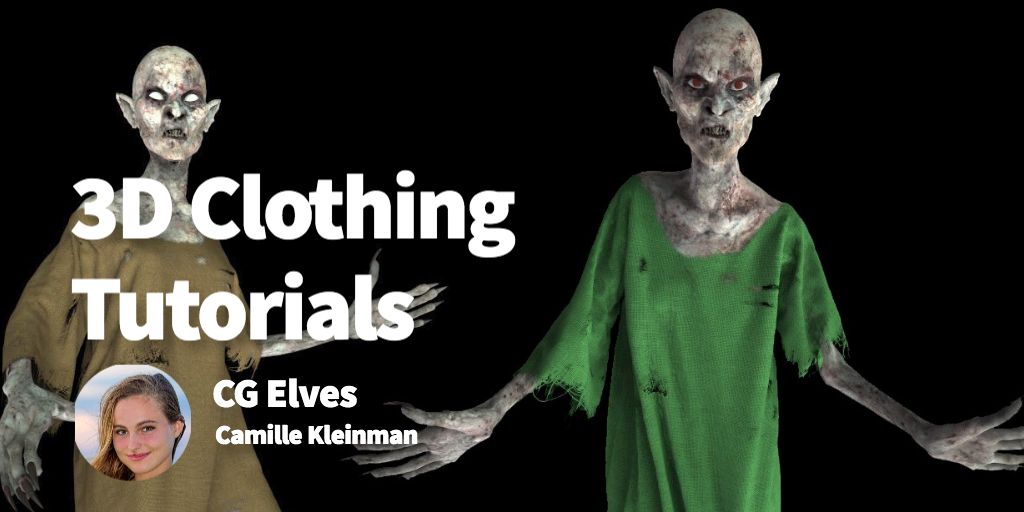I love art and my mother is an artist so I guess I got it from her. Around 5 years ago, I began to study digital sculpting and 3D character design.Back then, when 3D artists wanted to create 3D clothes for their characters, they had to spend hours upon hours sculpting every single wrinkle - and for every pose too!
To me, that seemed like a terribly tedious process. A week just to sculpt some clothing? Get outta here! After some research online, I stumbled across the Marvelous Designer software by accident. It’s developed by a Korean company and back then they weren’t very active marketing themselves so none of the artists knew about MD.
Five years ago, there were no courses anywhere online how to use Marvelous Designer. Even the manual was very lacking. After spending months figuring out how to use the program to design all the clothes I wanted, I posted a few of my clothes on my personal Facebook (with only 10 little friends who weren’t artists).
Somehow or another, one artist saw my work and begged me to tell him my secrets. “How do you create those amazing, realistic wrinkles?” He asked me.
After the first artist saw my work, he must have told another artist he knew because before long strangers I didn’t know began to send me friend requests and ask about tutorials. Almost all the artists at the time were men. When I told them about Marvelous Designer, the mere idea of “sewing clothes” (even though it was digital) horrified most of them. Sewing! Yuck, that’s a girl thing.

I remember one guy told me he kept struggling to use the software in vain. Near tears, he told me it was the bane of his existence; every garment he tried to make exploded and flew away. (Yes! I also experienced clothes exploding or flying out of sight at first because of wrong sewing/pressure settings. Here is one of my early mesh-explosions:)
So once I mastered how to create clothes in the software, I decided to help the poor guys and make tutorials for them. It took me many months to record the entire training program. I’m a bit of a perfectionist and spent (too much time probably) editing the sound to make it perfect. Shorten unnecessary parts of the videos (like slow cloth simulations) to save people time and make it more fun to watch.
While I was creating the training, I gathered around 50 people on my waiting list, who kept nagging me “When is it ready?” for months.
How did you get your first three customers for CG Elves?
Word-of-mouth and recommendations on Facebook.
When I finally launched CG Elves after many months, all I did was announce it on my personal Facebook wall and unleash the guys onto our website. Because it was something many artists needed, people tagged their friends in my post, shared my post on their own walls, spoke about it in forums and groups, and it just spread like fire on it’s own.
I didn’t have a marketing plan when I started out. I thought I’d simply make the training and then figure out the marketing part when I’d get to that. When I saw how powerful word-of-mouth marketing was, the first month after launching CG Elves, I spent networking hard on Facebook. Joining groups for artists, adding artists.
While adding people, I pinned a promo post about my training on my personal wall for all to see. This way, when people checked me out to see I wasn’t a spammer or to see who I was, they’d see my training promo. In the beginning, I think all our customers came from Facebook and word-of-mouth recommendations.
How did you validate the idea?
I thought Marvelous Designer would be a great way to save time making 3D clothes. I didn’t know if artists would adapt to using it or not. If everyone would hate sewing and not want to learn it. It was a bit of a risk, but I guess getting the first good feedback was a big encouragement to pursue it.
At first, the main hurdle was to not only spread awareness about what Marvelous Designer software was, but also to convince artists to dosh out $100’s to buy this new software and then more to buy my training. How did you fund the idea? I was 17-18 at the time and lived at home with my mom. Previously, both me and my mom had spent months working online for a client. She did SEO, content marketing, and managed a team, while I wrote educational articles, edited website posts others made, build up backlinks, and designed educational worksheets for kids etc.
We’d saved up some money from that work so I was able to focus for a year on creating Marvelous Designer training without having to work for another client. Who is your target demographic? Our clients are pretty varied. All ages, although mainly male. Some are students, some are hobbyists, some are pros. Most of them are 3D artists/character artists or animators. Amongst the 3D artists we have professionals who work for top game studios or film studios on AAA video games or movies. We also have DAZ/Poser/iClone users and hobbyists who create use 3D to create beautiful book covers, 3D animations for Youtube videos, and concept art.Now and then we also have some fashion students.
Some of our clients are creators who make 3D clothing for sale for special characters/software like DAZ3D, Poser, iClone, or virtual worlds like Sansar/SecondLife. Did you know SecondLife is a huge virtual world multiplayer game? Since its launch around 12 years ago, creators made $500 million selling digital 3D products to other players such as clothes, homes, furniture, hair, skins etc. What is the most unusual customer you’ve had? A law firm. I didn’t think lawyers needed to learn 3D clothing design but apparently, some law firms reconstruct crime scenes in 3D and want to make the animation look as realistic as possible. I guess showing a realistic animation in court of how your client said the accident/crime happened is a great way to convince the jury since it’s very visual.
Where did you meet your co-founder?
My mom is the co-founder. She built the entire website and membership area etc. I made the training and did online marketing, outreach to companies (to sell our products to studios and to get us partners who’d promote us to their customers).
What clients do you typically work with?
We sell digital products so everyone is welcome! Of course, we have different pricing for companies than artists. Did you run any companies prior? Not a company, but I did sell muffins when I was 10. It was a lot of fun. Mom baked then and I went all around the neighborhood knocking on stranger’s doors, perfecting my art of selling. Of course, not everyone was nice. I’d get rude people slamming doors on my face, people threatening to call the police. But I also sold all my muffins, made extra money, and had very happy customers who loved the products and tipped me well. Does that count?
What motivated you to start your own business?
My mom always encouraged me to do my own businesses and not work a 9-5 job. As a kid, I often heard her playing all these self-help and motivational tapes in the background.
What were your family and friends first thoughts on CG Elves?
Most people don’t understand anything about 3D so before I had clothes to show, they’d just glaze over trying to comprehend what 3D clothes were and why on earth anyone would want to wear them. Wait, you can’t wear digital clothes, so what would you want to buy them for? For a 3D person who doesn’t exist. Okay, that doesn't make any sense.
Later, when people saw the clothes and it was easier to understand. What motivates you when things go wrong? Well, during the many months struggling to create clothes at first, a LOT went wrong. Sometimes, after my shirt blew up for the nth time and flew off the screen again, I’d break down crying in frustration. (Silly baby!)
I just kept at it until I found out how to do it right.
Recently, I’ve been coding complex automation systems, smart bots and chatbots. Although it’s not really creative, what I find really fun and fascinating is whenever something goes really wrong, whenever I hit a major roadblock, or whenever something seems utterly impossible. What’s fun about having challenges is that you get a chance to work your brain real hard to solve them. And then when you overcome and solve them, well, it feels like a great high.
Like as a kid (8 years old) when I went rock climbing in the Alps with a special group, there was one wall which only super pros could climb. Even our instructors and other adults didn’t dare try climbing it. Everyone who tried to climb it gave up after a few meters and came down again. “It’s impossible.” they all said. When I told our guide I wanted to climb it, they smiled and told me I couldn't do it. For some reason, hearing someone else tell me that I can’t do something, that something is impossible, really fires me up to do it. I made a bet with a boy my age (who echoed the adults “you can’t do it”) that I’d reach the very top.
It was hard. Oh boy, it was super hard. The wall was super smooth with hardly anything to grasp. Plus, because my mom was broke, I didn’t have rock climbing shoes. I had simple, flat-bottom city shoes (with worn-out soles). But I didn’t give up. I don’t know why. Stubbornness. Wanting to prove them wrong. Wanting to win that bet. I just kept clawing my way up that wall inch by inch, until every part of me ached and my fingers were crying for mercy. But I ignored the pain until I reached the top and won the bet.
It’s the same with work. When something is really hard and people say it’s impossible, I love proving them wrong. Do you have any advice for someone just starting out? Create something really, really valuable that will help a lot of people. Whether it’s training, a digital product, a service. Of course, the bigger the market the better. Do your very best. Make your product so great that people will love it and eagerly tell others about it on their own accord (without needing to bribe them - “share to get a freebie or coupon”).
Word-of-mouth is the best form of advertising. I was amazed at how many people went around forums and groups telling others about my products without me ever asking them to do that.
If you have a really crappy product, no one will want to recommend it, you’ll get bad reviews and bad mouthing online. Sure, many companies buy fake reviews and go through loops to remove or drown out bad ones, but that’s so much work and bad Karma. Instead, just make something really great. Any tips for finding first employees? Whatever tasks I want an employee to do, I always do them first myself. So I know everything that goes into it, how long it takes, challenges etc. It’s also easier to make training. Of course, once you grow you can have others hire and train your employees.
What has driven the most sales?
At first it was Facebook and word-of-mouth. Then I used online marketing techniques my mom taught me (back when I was 12) to promote myself online.
I did image marketing, forum marketing, content marketing, and freebie marketing. Also, I posted free tutorials on Youtube and Vimeo and I shared valuable, free digital products. It’s easy to promote freebies online. Easier than promoting paid products. For instance, posting about freebies in forums is allowed, while posting about paid products is seen as marketing/spamming.
People were happy with the free products and told others about them. Also, it was a great way to show them the quality of my products. When they saw the quality of my free tutorials/products, they felt more confident to pay for my paid products.
In fact, when I first started out, I recall some people who had been waiting for my course’s launch, were hesitant to buy since they’d never seen any free tutorials from me and didn't know if I could teach or not. Spending hundreds on an unknown course is a big gamble.
After I released some free tutorials, those who didn’t buy were convinced and bought within a day or two. Also reviews helped a lot, and getting some impressive partners on-board later on. What is stopping you being 3x the size you are now? The market is a limited size. There are only so many new 3D artists per year. It’s not a huge market like selling real clothes to humans. What are your favourite books? In general, I like reading horror screenplays or fantasy novels like GOT.
Self-Improvement: The Science of Getting Rich by Wallace Wattles, Napoleon Hill, Harv Eker, and various books on sales psychology, NLP, body language etc. What are the next products you’re working on? Currently, I’m creating courses teaching online marketing, lead gen, how to build various types of chatbots, and specific technical skills.
How do you protect yourself from competition?
There are some others who cloned some of my tutorials (including students) and posted them for free on Youtube or sell them for a few dollars. However, no one made such a comprehensive course as I did, nor such a huge library of presets. Even with copy-cats, our products are still the best quality out there and the best value for the money so people still recommend us and buy from us.
| Company Name: | CG Elves |
|---|---|
| Founder: | Camille Kleinman |






